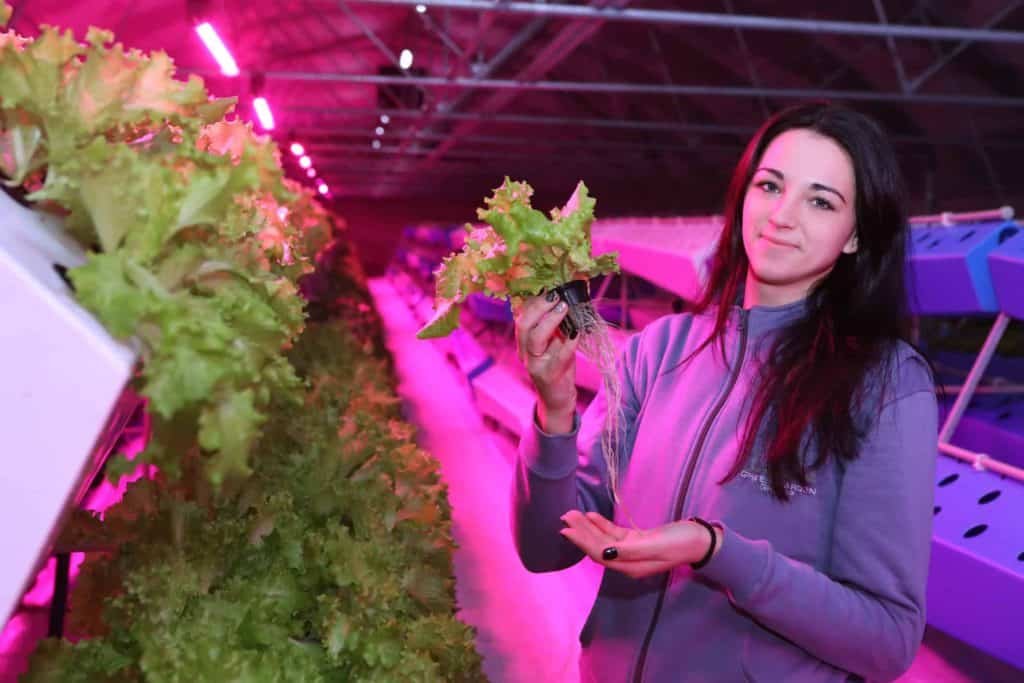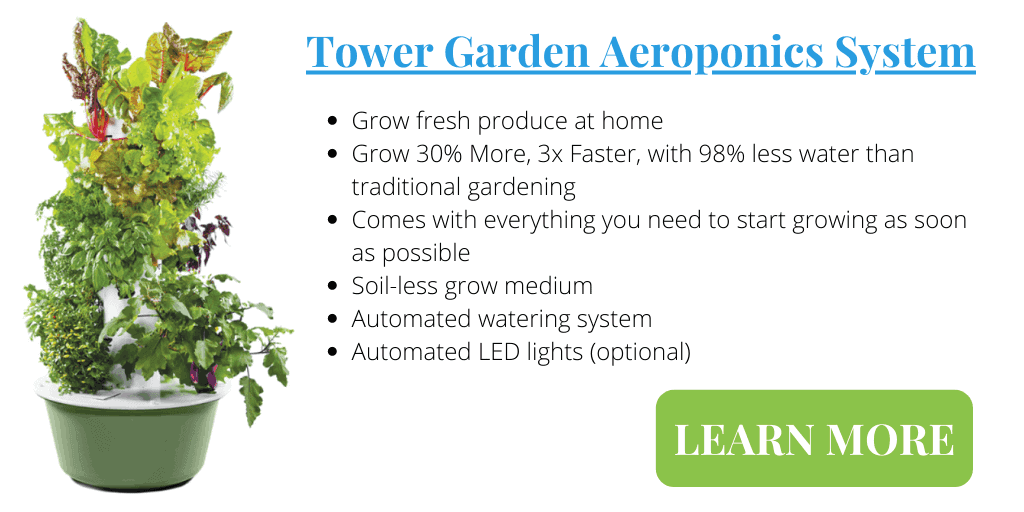Aeroponics is an agricultural technology that is becoming more and more popular in the twenty-first century. Using an aeroponic system, it is possible to grow large amounts of fruits and vegetables without even having an outdoor garden.
Aeroponics is a form of hydroponic farming that omits soil and many of the restraints of traditional vegetable gardens. It yields large amounts of produce in a small amount of space and is great for indoors. Because it can be used even in inhospitable climates, aeroponics is the key to increasing food supply in the twenty-first century and beyond.
Aeroponics isn’t just changing the agricultural industry, though. Read on and learn more about how you can use aeroponics in your own home to increase your self-reliance and food security as well as get some fresh vegetables.
How Aeroponics Increases Food Supply
There are many ways that aeroponics stands above other methods of growing fruits and vegetables as a technology for food production. Here are some of the things that make aeroponics stand out as state-of-the-art technology in the science of growing things:
- Lower water usage: Unlike hydroponics, which can be rather water-intensive, aeroponics uses the bare minimum water necessary to keep plants alive and healthy, eliminating wasted water and decreasing utility bills.
- Increased yield: Because indoor aeroponic systems aren’t subject to the whims of Mother Nature, they can put out a higher number of fruits and vegetables per square footage than your average outdoor garden. Aeroponics also allows farmers and gardeners to precisely measure the quality and quantity of nutrients their plants are getting to allow for maximum yield.
- Vertical farming: Aeroponics is one of the easiest ways to set up a vertical garden, which maximizes yield per square foot for a wide variety of fruits and vegetables. Not only is vertical aeroponic gardening an efficient use of space, but it is also easier harvesting for people with limited mobility and seniors.
- Fewer pests: Aeroponics setups have to deal with a lot fewer bugs and other produce-destroying pests than traditional gardens due to the lack of soil. Also, many aeroponics systems are set up indoors, so the few pests that are found are much easier to seek out and destroy without the use of inorganic pesticides.
- Indoor gardening: Aeroponics is the easiest agricultural method to use indoors since it uses a minimum amount of water, which can be messy indoors. Growing produce indoors offers many advantages, most of them to do related to not being subject to the whims of mother nature. Indoor gardening allows gardeners and farmers to harvest produce year-round, regardless of the weather.
- Faster grow cycles: Produce grown in aeroponic systems can grow more efficiently than vegetables and fruits that are grown outdoors since the person growing them can completely control the amount of light as well as the levels of moisture and nutrients added to the system.
There are tons of reasons why aeroponics has advantages over other growing systems, especially for those who otherwise have hostile growing conditions such as people who live in northern or arid climates. This goes not only for those who are trying to grow for commercial purposes but also for those people who are trying to grow fruits and vegetables for their household.

Ways Aeroponics Increases Food Supply
Aeroponics isn’t just useful for home gardens. This technology is a new way for the industry to increase the amount of produce that can be harvested from each square footage of space, and the growing conditions of aeroponics systems mean that aeroponics farms are just as easy to run in the middle of a city as they are in rural areas. This is important for food-scarce nations such as India and areas of Africa, where hostile growing conditions can make food supplies uncertain.
Many modern problems negatively affect food security across the world. Some of the issues that modern farmers and gardeners face:
- Depleted topsoil: The topsoil has become extremely depleted by the past two centuries of human evolution, and experts estimate that within sixty years, the majority of the world’s fertile topsoil will be gone. (Source) Aeroponics help humanity head this food crisis off by giving us a way to grow food that doesn’t require soil at all.
- Inorganic pollutants: Because conventional gardeners have to fight with insects and other vermin for their harvest, they are often forced to use pesticides and other chemicals that inevitably pollute the surrounding environment.
- Pollinator die-offs: The die-offs of bees, butterflies, and other pollinators in recent decades have had scientists concerned that there will not be enough organic pollinators left to pollinate crops around the world effectively. Aeroponics solves that by allowing people to easily hand-pollinate plants in indoor agricultural setups.
- Uncertain weather conditions due to climate change: The weather patterns each year on Earth are becoming more and more unpredictable as a result of climate change, with increased storms and other adverse weather conditions. Aeroponics farmers get ahead of the game by avoiding the weather entirely in indoor aeroponics setups.
Aeroponics offers a way for gardeners and farmers to get around all the above constraints that restrict how successful a modern farming plot can be. Instead, aeroponics relies on modern technology to gauge exactly how much light, moisture, and nutrition plants need to grow, ensuring that no resources go to waste in the process.
Decreasing Food Miles Using Aeroponics
Another major advantage that aeroponics offer for agriculture is decreasing food miles necessary to produce fresh fruit and vegetables. “Food miles” means the number of miles it takes to transport food from the area where it is harvested to the area where it is eventually sold and eaten. Foods that are imported from foreign countries have large numbers of food miles (equating to a large carbon footprint), while foods that are grown in your backyard are much more environmentally friendly. (Source)
Depending on where you live, what season it is, and what food you are purchasing will affect how many miles your food has had to travel to reach your plate. Unless you are purchasing your produce at a local farmers market, where you can pretty much guarantee the fruit and vegetables you are buying were grown within a 50mile radius, it’s hard to say how far your food has had to travel to reach you.
Aeroponics allows countries that have a difficult time growing crops in their native soil or climate a chance to grow crops indoors year-round, not only decreasing the necessity for imported food and the number of overall food miles being used but also offering people a source of fresh local food as a healthy alternative to imports.
Aeroponics also helps to sustain communities with short growing seasons or—because of year-round snows—no growing season at all. With an aeroponic system, even communities in the middle of winter can have access to fresh fruits and vegetables no matter how cold and inhospitable to vegetation it is outside.
Growing Your Food at Home with Aeroponics
Along with the benefits it presents to industrial agriculture and international food security, aeroponics is also a convenient way to grow produce at home. Some of the benefits of growing with an aeroponics system in the household:
- Perfect for kitchen gardens: Fresh herbs used in cooking rarely transport or store well at grocery stores, and the best option for flavorful herbs is to grow them yourself. Aeroponics is a perfect cut-and-come-again growing system that can be attached directly to the interior of the kitchen for the cook’s convenience.
- Easy setup: Once you have your aeroponics system built, it is very low maintenance in comparison to conventional gardening plots. (Source)
Aeroponics is a great way to harvest homegrown vegetables even if you don’t have the land to grow on or live in the middle of a major cosmopolitan area. Thanks to aeroponics, even the hearts of cities are beginning to see farms blossom.
One of the top Aeroponic systems used both commercially and at home is the Tower Garden. This is a 5 foot tower with a 3 foot radius capable of growing 20 to 32 plants. It’s expandable to become taller and grow even more plants.

Companies Using Aeroponics to Increase Food Supply
Many companies are jumping on the bandwagon to convert their agricultural programs into aeroponics-based systems. Some companies have taken the reins on the technology and are leading the charge when it comes to learning how to use aeroponics on a mass-production scale most effectively.
Here are a few farms that are currently leading the way in aeroponics production:
- Tiger Corner Farms – uses recycled shipping containers to house farm pod that consist of stacked horizontal aeroponic systems
- Aerofarms – indoor vertical farming consisting of stacked aeroponic plant trays
- Bright Farms – utilizes hydroponic farming techniques in indoor greenhouses.
- Freight Farms – utilizes hydroponic vertical farming in recycled shipping containers.
- True Garden – uses multiple Tower Gardens to create Tower Farms
Aeroponics saves farmers money during the investment phase of getting a farm up and running by eliminating the need for farmers to spend a lot of time, energy, and money trying to prepare the land for maximum yield.
They are forced to do this while simultaneously fighting increasingly unpredictable weather patterns going into the twenty-first century. Farmers switching to aeroponic systems isn’t just a good idea—soon, the majority of them will have no choice.
Closing Thoughts
Whether you’re looking to get on the leading edge of agricultural production or you want a kitchen garden that produces a ton of herbs and vegetables without breaking your back outdoors, aeroponics is the perfect growing system to try.
